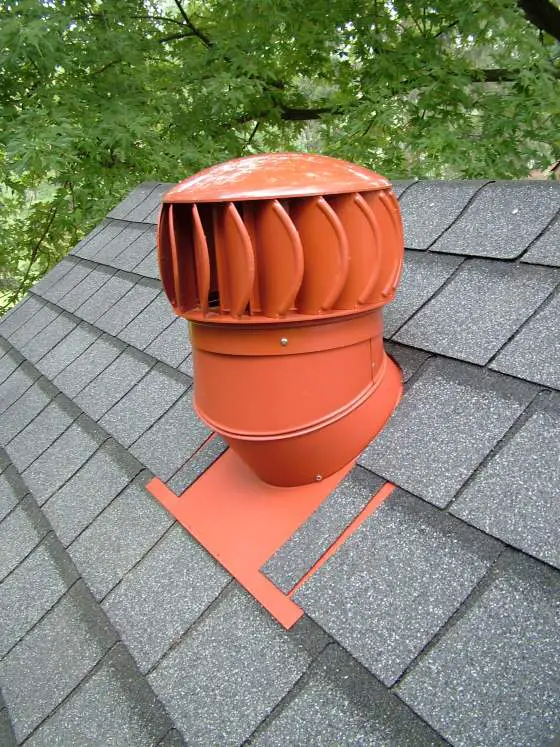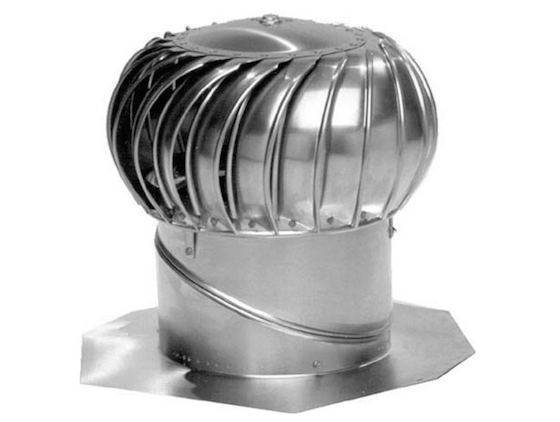Roof Ventilation with Turbine Vents

Roof Ventilation with Turbine Vent | This turbine vent spins with just the slightest breeze. It is but one tool to use when you want superior attic ventilation. The top part of this vent was made from durable plastic. The vent was manufactured in Australia. It was on my Queen Anne Victorian garden shed in Cincinnati. PHOTO CREDIT: Tim Carter
Roof Ventilation With Turbine Vent TIPS
- Ridge vents are inferior
- Hot air rises but doesn't go down
- WATCH install videos below
- Turbine vents suck lots of air from attics
- CLICK HERE to Get Tim's FREE & FUNNY Newsletter!
Is Roof Ventilation Important?
Yes, roof ventilation is very important. The more you can get the better.
The roof-ventilation rage over the past fifteen years has been continuous ridge and soffit ventilation. These systems are nearly invisible and they create a system through which air enters your attic space and then gently floats through the attic space.
But I've discovered over the years there's a much better product to use to ventilate an attic.
Do Ridge Vents Work All the Time?
Ridge vents do not work all the time. In hot weather with no wind, no air floats out of your attic space.
The companies that make the ridge ventilation products claim that no matter what the time of year, the air exits the attic space through small gaps at the peak of the roof. I've tested this claim, or hypothesis, and it doesn't work in the summertime.
IMPORTANT TIP: I'll explain more in a moment, but realize that hot air rises, it doesn't go down.
At the peak of your roof there's a gap in the wood sheathing.
This gap is covered with any number of different products that allow air to pass, but prohibit rain, snow and insects from entering your attic area. You can't see these vents as they are almost always covered by the roofing shingles at the peak.
Ridge Vent Gap Video
Watch the video just below to see this gap. You'll see it about 1:40 into the video. If you want to advance to that point, just do so. Realize this gap you see is where the air comes out of the underside of the roof.
What is the Physics of Hot Air?
The mechanics of the air movement are quite simple. During warm weather, the air inside your attic heats up. Since warm air rises, it tends to float out of the highest ventilation spaces. As air leaves your attic, more air has to replace it.
The conventional wisdom is to put in soffit vents down at the bottom of the roof so the replacement air can enter here and flow up under all the roof sheathing. This convection movement naturally draws in cooler outside air to replace the air that just exited.
Does Wind Suck Air From Attics?
Yes, wind does suck air from attics. It's called the venturi effect.
Wind that blows across the roof anytime of year also acts to vacuum air from the attic space. The wind blowing across a roof can create a partial vacuum on the leeward side of a roof. When the wind blows and at the right angle a significant amount of air can be pulled through the attic space by the vacuum created as wind blows across the peak of the roof covered with a ridge vent.
Can You Test Ridge Vents With Incense?
I loved taking physics in high school and college. There I discovered that hot air rises and cold air falls down.
For a ridge vent to work, the hot air has to rise up to the peak under the shingles, then it needs to go down several inches in altitude to get out of the ridge vent.
That seemed impossible to me. I decided to test it.
I went up into my attic on a blistering hot day around 1 pm. The sun had been beating on my roof for hours and it was probably 145 F up there.
I made sure there was no wind outdoors. It was a calm humid Cincinnati summer day.
I lit a stick of incense and held the stick about 10 inches down from the underside of my continuous ridge vent.
Smoke from the incense floated lazily up but it was NOT drawn out of the ridge vent. It just sat up near the peak of the roof.
Are Turbine Vents The Best Ventilation?
In my opinion, turbine vents are the best ventilation. They work with just the slightest breeze.
Turbine vents can vacuum vast quantities of air from an attic space on a windy day. It's the common turbine vent. Some people call them whirlybirds or whirlybirds.
These balance ventilators have a dome that spins on high-quality ball bearings. Just hot air rising out of one will make it spin.
If the wind is blowing and catches the fins, then the turbines act like giant vacuum pumps sucking hundreds of cubic feet of hot air out of an attic per minute.
The faster the wind speed, the faster the turbine rotates.

This is a standard turbine vent. They come in different colors. Some have external braces. This one you see is Made in the USA. CLICK THE IMAGE TO ORDER ONE OF THESE GREAT TURBINE VENTS.
Turbine Vents are Time Tested
Turbine vents have been used for many years in both residential, commercial, agricultural and industrial buildings. The vents are very affordable, easy to install, and they pump vast amounts of air from attic spaces.
CLICK HERE to see an assortment of turbine vents that I've used on my jobs. Made in the USA!
A Small Turbine = Lots Of Air
A small 12-inch diameter turbine vent with a constant wind speed of 5 miles per hour (mph) can remove 347 cubic feet of air per minute (cfm) from the attic space.
A single 14-inch diameter turbine vent that is subjected to 15 mph winds can expel up to 1,342 cfm of air! If the winds are still, the vents still allow air to drift up and out of the attic space, although not nearly as much.
How Much Attic Air Change is Required?
Those amounts of air might not mean much to you at first blush. But consider a moderately sized home whose attic space is 36 feet deep, 50 feet long and 10 feet high at the peak. This attic space contains 18,000 cubic feet of air.
A single 12 inch diameter turbine vent could provide a complete change of air in the attic space every 52 minutes if the outside breeze was just 5 mph.
The 14 inch diameter unit could provide a complete air change in the attic every 14 minutes at 15 mph. Imagine what happens if you install two or three of these simplistic turbine vents on the back side of your roof out of view!
Can You Achieve a Leak-Proof Installation with Turbine Vents?
It's easy to install a turbine vent and have no roof leaks.
The roofer your builder hires can install a turbine vent in less than 15 minutes. The average cost of a high quality turbine vent is just $50. The best ones provide years of maintenance-free service since they have permanently sealed ball bearings.
Roof Flashing Video
Watch this video of me installing a bathroom vent fan hood. It's the EXACT SAME process for a roof turbine vent. Nothing about the install is different.
If your roof is not too steep and you have asphalt shingles, this is a DIY project. Once again, watch this video and imagine I'm installing a turbine vent. The base flashing of the turbine vent is IDENTICAL to the bath fan flashing you'll see.
No Leaks
Many people look at the vents and think they will leak during a rainstorm. The wind that almost always accompanies a rain shower or storm actually causes the turbine to spin and blow rain drops away from the vent. The same is true for snow.
If you want the strongest turbine vent, be sure to buy one that has external braces. These are simple metal braces that extend out beyond the spinning turbine. These visible braces do a fantastic job of stabilizing the turbine when the winds are really blowing.
Column NH039
36 Responses to Roof Ventilation with Turbine Vents